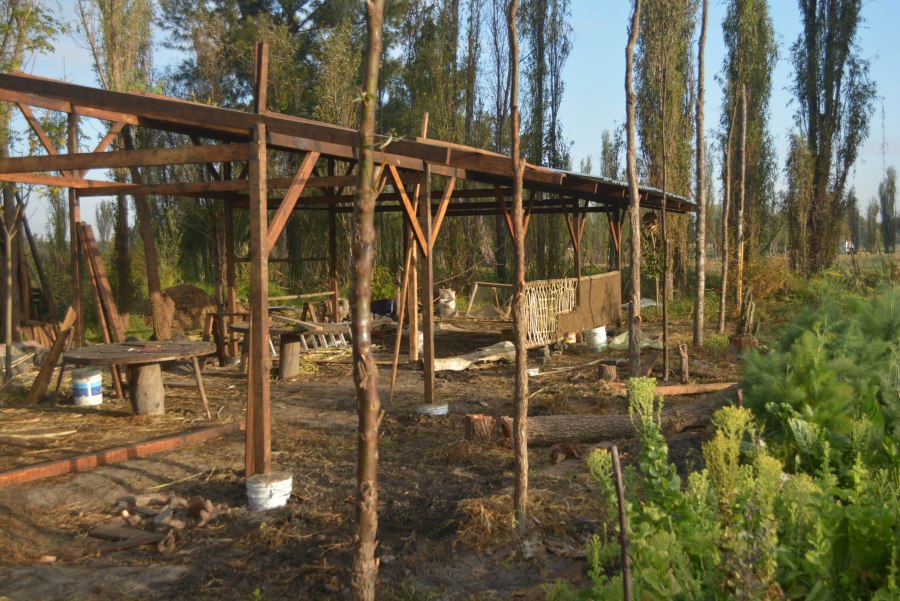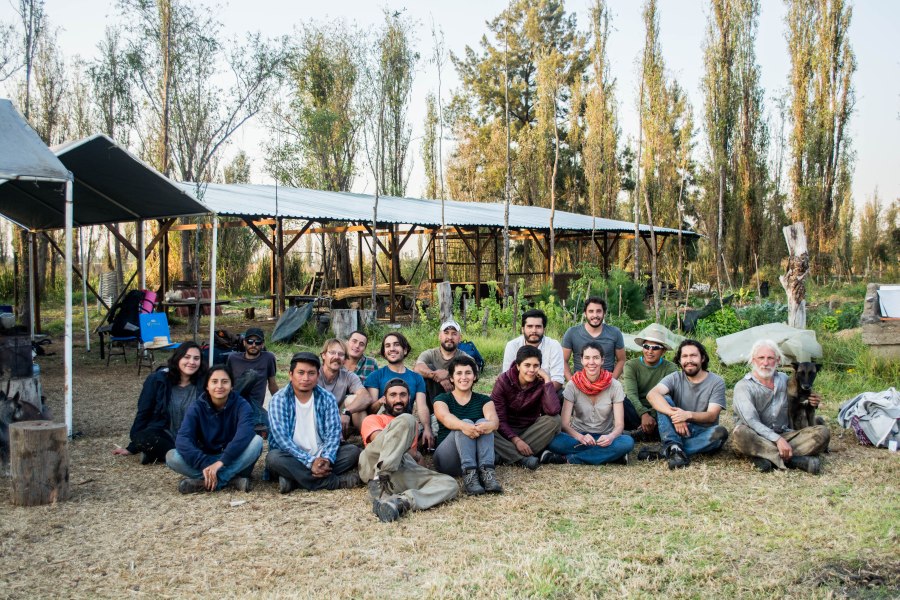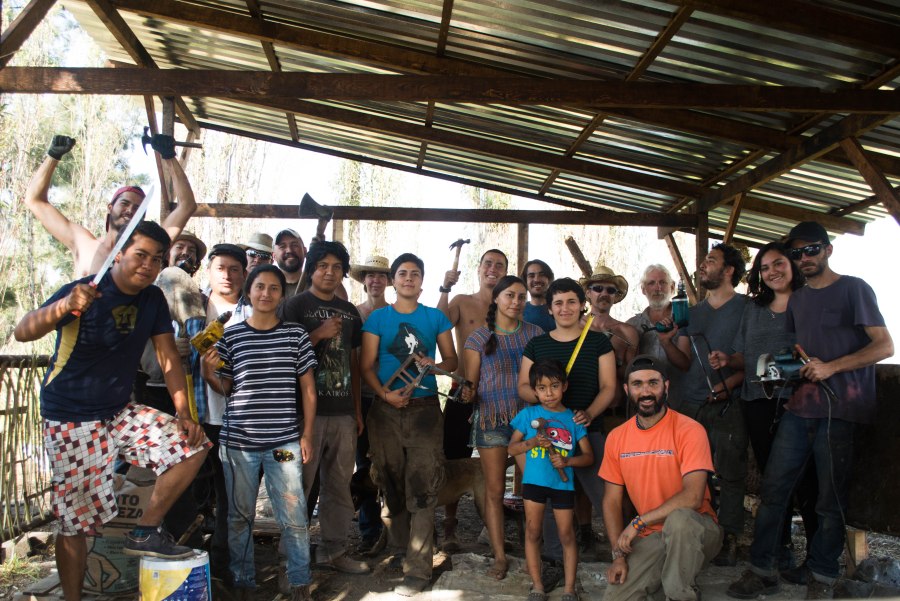Previously I have written about the Chinampa. About Xochimilco in general, and about the Chinampa Tlicuilli in specific, who organized a crowdfunding campaign to finance their construction of a kitchen / dining room / multi-purpose building. The campaign came to a close, and even though only a thousand dollars had come together from the original goal of five thousand, it was a thousand dollars more than they’d originally had at their disposal. So the project was stripped of all non-essential features, such as the photovoltaic system, and the two-week workshop was given a go to proceed as planned.
It was scheduled to take place from 7th to 21st of December, an ideal time to escape the Jingle Bells and X-mas stress of the season. The weather is also quite pleasant around this time, with even the extended rainy season behind us. Sure, the mornings could be crispy cold, but once the sun was up you could take off your shirt, and almost every day was guaranteed to be sunny. Plus, around mid December the everyday-work-life in Mexico tends to slow down, if not coming to a complete halt, so dedicated volunteers could join us in this project. And join they did! Some were locals from Mexico City, who would arrive in the morning and leave in the afternoon after the day’s work was done. Others came from further away, camping on the chinampa throughout the course. Some volunteers even came from other countries, such as Italy, Sweden, or Colombia. Though, as it is usually the case with projects like this, not everybody was here all the time. Some people left early, others arrived late, some only stayed for a day, and still others, such as myself, had to leave for a day or two, then came back. But in any case, there were always somewhere between 5 and 20 volunteers present at any given time.
 The objective of the build was to construct a decent shelter for food preparation and consumption. The previous infrastructure was a lightweight metal frame with a well aged plastic tarp over it, approaching the limit of its usefulness. Also, the space it offered was rather cramped, especially in times of rain. The new structure was going to be a 18 x 4 m (59 x 13 ft) wooden frame building, with cob walls in between, and a sloped roof of 20 x 6 m (66 x 20 ft), covered with steel lamina. At first we were going to build a bamboo structure, but due to some logistical problems we had to result to using wood instead. For the last couple of days the construction we also planned to build a so called Lorena Stove and an Horno Chileno, just in case we finished the building ahead of time. We didn’t, so these interesting features will have to wait till next time. As for the flooring, we didn’t even attempt to include it, though we spent a bit of time brainstorming the various options with their pros and cons.
The objective of the build was to construct a decent shelter for food preparation and consumption. The previous infrastructure was a lightweight metal frame with a well aged plastic tarp over it, approaching the limit of its usefulness. Also, the space it offered was rather cramped, especially in times of rain. The new structure was going to be a 18 x 4 m (59 x 13 ft) wooden frame building, with cob walls in between, and a sloped roof of 20 x 6 m (66 x 20 ft), covered with steel lamina. At first we were going to build a bamboo structure, but due to some logistical problems we had to result to using wood instead. For the last couple of days the construction we also planned to build a so called Lorena Stove and an Horno Chileno, just in case we finished the building ahead of time. We didn’t, so these interesting features will have to wait till next time. As for the flooring, we didn’t even attempt to include it, though we spent a bit of time brainstorming the various options with their pros and cons.
 The first day was spent arriving, which is always a bit of a challenge even if you don’t have a lot to carry. Then we set up the volunteer camp. A solar shower provided hot water in the late afternoon, and the kitchen-tarp was moved from the construction site to give us a decent place to cook and eat. We also set up a white tarp in the small cob hut for projecting movies onto. This is where we would show documentaries in the evenings related to Permaculture and Natural Building.
The first day was spent arriving, which is always a bit of a challenge even if you don’t have a lot to carry. Then we set up the volunteer camp. A solar shower provided hot water in the late afternoon, and the kitchen-tarp was moved from the construction site to give us a decent place to cook and eat. We also set up a white tarp in the small cob hut for projecting movies onto. This is where we would show documentaries in the evenings related to Permaculture and Natural Building.  This hut, which otherwise serves as a (un-)dressing room in front of the Temazcal, was also where we set up our electronics station, with a borrowed solar panel on the roof to charge devices and power the speakers for music during the day. Unfortunately the wind generator, which still rotates happily in the wind, had its inverter and battery stolen, so it joined the ranks of the many semi-functional features of the site.
This hut, which otherwise serves as a (un-)dressing room in front of the Temazcal, was also where we set up our electronics station, with a borrowed solar panel on the roof to charge devices and power the speakers for music during the day. Unfortunately the wind generator, which still rotates happily in the wind, had its inverter and battery stolen, so it joined the ranks of the many semi-functional features of the site.
 One thing I personally brought to add to the experience of camping was my huge German scout tent, made out of heavy duty cotton without a floor piece, so a campfire could be built inside. At first I intended it to be somewhat of an experimental curiosity, but in the end it became a huge hit. Since the temperatures tended to plummet to somewhere between slightly chilly and freakin’ cold as soon as the sun went down, a campfire was usually called for. This we’ve made every night without exception. However, it is much nicer to sit around a fire where your back doesn’t have to be cold either! And my tent could accommodate up to 13 people at once, probably more, but that was our maximum number one night.
One thing I personally brought to add to the experience of camping was my huge German scout tent, made out of heavy duty cotton without a floor piece, so a campfire could be built inside. At first I intended it to be somewhat of an experimental curiosity, but in the end it became a huge hit. Since the temperatures tended to plummet to somewhere between slightly chilly and freakin’ cold as soon as the sun went down, a campfire was usually called for. This we’ve made every night without exception. However, it is much nicer to sit around a fire where your back doesn’t have to be cold either! And my tent could accommodate up to 13 people at once, probably more, but that was our maximum number one night. We would gather there, one by one, make quesadillas over the fire, heat water for tea, eat, drink, smoke, and talk late into the night. Eventually, some people decided that it offered a cozier sleeping space than their unheated nylon tents, even with the smoke-hole on top, that would let some of the heat escape. Of course, a good sleeping bag is still the best option to stay warm, but hot coals in the fire-pit also make a big difference.
We would gather there, one by one, make quesadillas over the fire, heat water for tea, eat, drink, smoke, and talk late into the night. Eventually, some people decided that it offered a cozier sleeping space than their unheated nylon tents, even with the smoke-hole on top, that would let some of the heat escape. Of course, a good sleeping bag is still the best option to stay warm, but hot coals in the fire-pit also make a big difference.
 Once we were ready to work, we started clearing the building site. This meant cutting the heavy growth of grasses, and picking up all the items uncovered in this process. Since the building was going to be wider and longer than the original tarp frame, we even had to move the line of trees growing just in front of the kitchen. Transplanting a tree usually consists of a bit more than just cutting the stem and sticking it into the ground a bit further down… however the Ahuejote tree doesn’t seem to mind this crude treatment. To maximize their chances to grow new roots, we removed all but their top branches, and gave each tree a bucketful of chapín, the nutrient rich mud from the bottom of the canal. Then they just had to be watered regularly and they would grow back to their normal selves.
Once we were ready to work, we started clearing the building site. This meant cutting the heavy growth of grasses, and picking up all the items uncovered in this process. Since the building was going to be wider and longer than the original tarp frame, we even had to move the line of trees growing just in front of the kitchen. Transplanting a tree usually consists of a bit more than just cutting the stem and sticking it into the ground a bit further down… however the Ahuejote tree doesn’t seem to mind this crude treatment. To maximize their chances to grow new roots, we removed all but their top branches, and gave each tree a bucketful of chapín, the nutrient rich mud from the bottom of the canal. Then they just had to be watered regularly and they would grow back to their normal selves.
 Next, the material for framing had to be measured, cut, and painted with oil, then prepared for assembly, while the buckets for the footing were dug in the ground, filled partially with gravel and concrete, to support the columns. The material we used were 4x4s, 2x4s, and 2x6s, as well as 2” strips of lumber to carry the metal sheets.
Next, the material for framing had to be measured, cut, and painted with oil, then prepared for assembly, while the buckets for the footing were dug in the ground, filled partially with gravel and concrete, to support the columns. The material we used were 4x4s, 2x4s, and 2x6s, as well as 2” strips of lumber to carry the metal sheets.
 Meanwhile, another team prepared the material for the cob walls. They cut reed branches, removed the leaves, and split them in halves. This would be fixed with wires between the structural lumber to carry the cob mix. They also prepared the ingredients for this: tepetate, a type of fine grained dirt, and horse manure. We planned to make enough cob not only for the kitchen building, but also to cover the tool-shed with it, and repair some minor damages on the wall of the smaller cob hut in front of the Temazcal.
Meanwhile, another team prepared the material for the cob walls. They cut reed branches, removed the leaves, and split them in halves. This would be fixed with wires between the structural lumber to carry the cob mix. They also prepared the ingredients for this: tepetate, a type of fine grained dirt, and horse manure. We planned to make enough cob not only for the kitchen building, but also to cover the tool-shed with it, and repair some minor damages on the wall of the smaller cob hut in front of the Temazcal.
 All this preparation seemed to take a bit long, but by the time the first columns were concreted in and attached to the frame of the roof, we were a day ahead of schedule. This was the time I had to leave in order to deliver some probiotic drinks to be sold at the market, so I was imagining how much progress the group would make by the time I’d return. As I was crossing the canal on my way back, I received the horrible news: the collapse of the entire structure! Fortunately, though, nobody got hurt, so it was treated as a minor setback, and as I got back to the chinampa, I was greeted by a rebuilt and reinforced building. That evening we even finished putting the roof beams on.
All this preparation seemed to take a bit long, but by the time the first columns were concreted in and attached to the frame of the roof, we were a day ahead of schedule. This was the time I had to leave in order to deliver some probiotic drinks to be sold at the market, so I was imagining how much progress the group would make by the time I’d return. As I was crossing the canal on my way back, I received the horrible news: the collapse of the entire structure! Fortunately, though, nobody got hurt, so it was treated as a minor setback, and as I got back to the chinampa, I was greeted by a rebuilt and reinforced building. That evening we even finished putting the roof beams on.

The collapse did take some toll in material, however, reducing the length of the building by a third. At first it seemed like that’s how we would have to keep it, but in the last minute some additional material arrived, and we managed to complete the roof as planned. Of course the remaining days were becoming more and more a race against time. We gave up on completing the kitchen facilities, and even the cob walls were given second priority. The new lumber had to be measured, cut, painted, and assembled (including some damage control for the occasional mis-measure and wrong cuts). Eventually, however, just after 5 p.m. on our last day, the last screw was drilled into the last lamina, accompanied by a thundering applause.

Sure, that was our last day. Initially it was intended to be a mere half-day, only for taking down the camp and cleaning up after two weeks of chinampa life. But even so, it didn’t mean that we missed out on the celebration. The previous night we had a huge bonfire, which started out as a smaller one for roasting a pig. The animal was brought to the chinampa live, butchered, cleaned and cut in two halves. One of our neighbors prepared one half according to the “carnita” recipe, boiled in its own fat, and the other one spit roasted over coals. By the time darkness descended, we were standing or sitting around the fire, eagerly anticipating the greasy pieces of meat. Unappealing as it may sound, it was a pure delight! We cut them up into small pieces, and ate them with tortillas and tequila. There was some salsa, lime, and salt there as well, but honestly, the fatty pieces of meat were delicious by themselves. The tequila helped to cut the grease, and the fat in turn lined our stomachs, keeping us from getting drunk to quickly. What an ideal combination. The fact that it just happened to be the night of the solstice made it even more perfect, sending us off towards the new year with a feeling of successful completion, looking forward to similar projects in the future.


Gran relato! Fue como revivir toda la experiencia! Gracias!
LikeLike
Gracias! Que chido que te gustó!
LikeLike